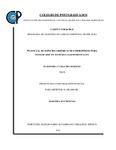| dc.contributor.author | Camacho Moreno, Eleonora | |
| dc.creator | CAMACHO MORENO, ELEONORA; 397473 | |
| dc.date.accessioned | 2019-09-05T17:43:18Z | |
| dc.date.available | 2019-09-05T17:43:18Z | |
| dc.date.issued | 2016-06 | |
| dc.identifier.uri | http://hdl.handle.net/10521/4017 | |
| dc.description | Tesis (Maestría en Ciencias, especialista en Agroecosistemas Tropicales).- Colegio de Postgraduados, 2016. | es_MX |
| dc.description.abstract | Se estudió el potencial de las especies Calyptranthes schiedeana, Lysiloma acapulcense y Tabebuia chrysantha, para ser implementadas en sistemas agroforestales. Se evaluó la fenología, arquitectura arbórea, etnobotánica y el potencial de adopción de los árboles. La fenología incluyó siete etapas de crecimiento: 1) formación de yemas florales, 2) floración, 3) fructificación, 4) dispersión de semillas, 5) presencia, 6) caída y 7) brote de hojas, de Febrero 2014 a Marzo 2015, y se relacionaron con la temperatura y precipitación. Se midió el ángulo de inserción de las ramas de primero, segundo y tercer orden y la morfología de copa para obtener los modelos de crecimiento. Se obtuvieron los índices de conocimiento local de las especies, valor de uso e importancia cultural, y se determinó el índice de adopción y la probabilidad de adopción. Todas las especies mostraron una fenología característica a especies de selva baja caducifolia, sin embargo, L. acapulcense mantiene sus hojas durante casi todo el año; algunas etapas fenológicas (floración), están asociadas a la temperatura y precipitación en todas las especies. Lysiloma acapulcense destacó en ser la especie de mayor tamaño, con el modelo de crecimiento de Troll, C. schiedeana adoptó el modelo Attims y T. chrysantha el modelo Leeuwenberg. Los productores mostraron el mismo conocimiento por cada especie (P=0.943), sin embargo, el conocimiento entre comunidades difirió (P=0.0002); L. acapulcense resultó con mayor importancia cultural (P<0.0001) y más preferida por los agricultores; además, solo dos comunidades se interesaron más en la adopción de las especies (P<0.05), con distinta probabilidad de adoptar los árboles (P<0.0001). Lysiloma acapulcense mostró los mejores atributos fenológicos y de arquitectura arbórea, así como la preferencia por los productores para establecerse en sistemas agroforestales. _______________ POTENCIAL OF MULTIPURPOSE TREE TO INTEGRATE IN AGROFORESTRY SYSTEMS. ABSTRACT: The potential of the species Calyptranthes schiedeana, Lysiloma acapulcense and Tabebuia chrysantha for use in agroforestry systems was studied. Tree phenology, tree architecture, ethnobotanical value and potential use of the trees by producers were evaluated. Tree phenology included seven stages: 1) flower bud formation, 2) flowering, 3) fruiting, 4) seed dispersal, 5) presence, 6) leaf fall, and 7) leaf budding, and were assessed from February 2014 to March 2015 relative to temperature and precipitation. The insertion angle for first, second and third order branches, and crown morphology also were recorded for use in growth models. Indices of local knowledge of species, use value and cultural importance also were obtained, as were indices of adoption and probability of use. All species showed phenologies characteristic of tropical lowland deciduous forest. Lysiloma acapulcense kept its leaves throughout most of the year, and flowering was associated with temperature and precipitation in all species. Lysiloma acapulcense was the largest of the three species and followed the Troll growth model, C. schiedeana followed the Attims growth model, and T. chrysantha followed the Leeuwenberg growth model. Producers possessed the same knowledge of each species (P=0.943), yet knowledge between communities was not the same (P=0.0002). Lysiloma acapulcense had more cultural significance (P<0.0001) and was most preferred by producers. Only two communities were interested in using the species (P <0.05) (but with a different probability of using the trees (P<0.0001). Lysiloma acapulcense showed the best phenological attributes and tree architecture, and was most preferred by producers for establishment in agroforestry systems. | es_MX |
| dc.description.sponsorship | Consejo Nacional de Ciencia y Tecnología (CONACyT). | es_MX |
| dc.format | pdf | es_MX |
| dc.language.iso | spa | es_MX |
| dc.rights.uri | http://creativecommons.org/licenses/by-nc-nd/4.0 | es_MX |
| dc.subject | Lysiloma acapulcense | es_MX |
| dc.subject | Tabebuia chrysantha | es_MX |
| dc.subject | Calyptranthes schiedeana | es_MX |
| dc.subject | Fenología | es_MX |
| dc.subject | Arquitectura arbórea | es_MX |
| dc.subject | Conocimiento local | es_MX |
| dc.subject | Sistemas agroforestales | es_MX |
| dc.subject | Phenology | es_MX |
| dc.subject | Tree architecture | es_MX |
| dc.subject | Local knowledge | es_MX |
| dc.subject | Agroforestry systems | es_MX |
| dc.subject | Agroecosistemas Tropicales | es_MX |
| dc.subject | Maestría | es_MX |
| dc.subject.classification | CIENCIAS AGROPECUARIAS Y BIOTECNOLOGÍA::CIENCIAS AGRARIAS::CIENCIA FORESTAL::CONSERVACIÓN | es_MX |
| dc.title | Potencial de especies arbóreas multipropósito para integrarse en sistemas agroforestales. | es_MX |
| dc.type | Tesis | es_MX |
| Tesis.contributor.advisor | López Ortiz, Silvia | |
| Tesis.contributor.advisor | Olguín Palacios, Carlos | |
| Tesis.contributor.advisor | Valdéz Hernández, Juan Ignacio | |
| Tesis.contributor.advisor | Suárez Islas, Alfonso | |
| Tesis.date.submitted | 2016-06 | |
| Tesis.date.accesioned | 2017 | |
| Tesis.date.available | 2017 | |
| Tesis.format.mimetype | pdf | es_MX |
| Tesis.format.extent | 1,477 KB | es_MX |
| Tesis.subject.nal | Agroforestería | es_MX |
| Tesis.subject.nal | Agroforestry | es_MX |
| Tesis.subject.nal | Etnobotánica | es_MX |
| Tesis.subject.nal | Ethnobotany | es_MX |
| Tesis.subject.nal | Conocimiento tradicional | es_MX |
| Tesis.subject.nal | Indigenous knowledge | es_MX |
| Tesis.subject.nal | Ejido Bandera de Juárez, municipio de Paso de Ovejas, Veracruz, México | es_MX |
| Tesis.subject.nal | Ejido Paso Panal, municipio de Paso de Ovejas, Veracruz, México | es_MX |
| Tesis.subject.nal | Ejido Patancán, municipio de Paso de Ovejas, Veracruz, México | es_MX |
| Tesis.rights | Acceso abierto | es_MX |
| Articulos.subject.classification | Introducción de árboles | es_MX |
| dc.type.conacyt | masterThesis | es_MX |
| dc.identificator | 6||31||3106||310601 | es_MX |
| dc.contributor.director | LÓPEZ ORTIZ, SILVIA; 31926 | |
| dc.audience | generalPublic | es_MX |


